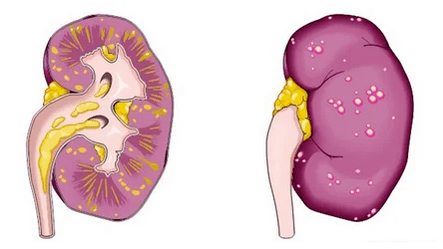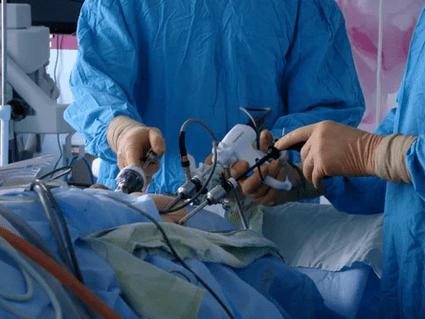
Many doctors call male prostatitis prostatitis.This disease is diagnosed in 20% of cases in men after forty years, in 70%, after sixty years and in 90% of cases after the age of seventy years.The disease can occur in two forms: acute and chronic prostatitis.This disease should be treated, especially because it lends itself well to therapy.But many men ignore unpleasant symptoms, which leads to the development of many complications that become more difficult to cure.
The reasons for development
Acute prostatitis is an acute pathology of the prostate, which develops as a result of the infectious inflammatory process in the organ due to the penetration of pathogens in their tissue.The disease is characterized by the appearance of swelling of the gland, purulent content in its tissues.This leads to the appearance of many unpleasant symptoms, the deteriorated functionality of the genitourinary system.
There are many causes of acute prostatitis.In most cases, it causesRoute microbes.Some of the microbes may exist in the body of a healthy person passively in the skin or in the intestines.Under the influence of some factors, they are activated, penetrate the tissues of the gland and actively multiply there.Often the ailment appears due to the STDs, for example,CLAMIDIA, UREPLASMIS, GONORREAetc
There is also an acute form of prostatitis as a complicationurethritis.The microbes fall through the ducts that open to the urethra.In addition, often the cause of prostatitis is the spread of bacteria of other organs of the genitourinary system.Often, iron can be affectedDuring surgical manipulations, catheterization, diagnostic measures.
Since there are a lot of blood vessels in the prostate gland, the infection here can obtain with a blood torrent in the presence of chronic pathologies in the body, for example, for example,Tonsillitis, bronchitis etcYeahanal cracksPerhaps the penetration of microbes in a prostate with a lymphatic current.
But infections do not always lead to the development of the disease.Stagnant phenomena in the glasses of the pelvic region that developwith prolonged abstinence of sexual contacts or a large number.
Stagnant phenomena are associated withLack of physical activity, constant constipation, alcoholism, varicose veins in the pelvic region, body hypothermia.
Classification
In urology, several forms of pathology are distinguished, which are their stages of development:
- Catarral formIt is characterized by the appearance of inflammation in the organ, a change in its mucous epithelium.Over time, the swelling of the gland occurs, a secret of mucous hype meets in it, contributing to the progression of the disease.
- Then the focal suppuration appears.The disease enters the second stage (form) -Folic form.Urinary ducts narrow or obstruct, the secret stops normally highlighting the organ.Pus can be released on the urinary channel, forming purulent spotlights there.The gland cells change, the prostate continues to increase and increase in size.
- Parenchymal formIt develops when the organ is completely inflamed, purulent infection develops in it.In the absence of therapy, the small purulent foci merger in a huge, an abscess develops, which often opens to the urethra, the intestines and the bladder.In some cases, it is possible to immediately develop this form of pathology when the infection penetrates the interstitial tissue of the organ with a flow of blood or lymph.

Symptoms
Symptoms are pronounced vividly.How much will be visible and notable the signs will depend on the form (stage) of the disease.The general signs of the disease include the following:
- Pain syndrome by eliminating urine;
- poisoning symptoms;
- pain in the genital region;
- Frequent registration to the bathroom, especially at night;
- Urethra's discharges are possible.
As prostatitis progresses in a man, pain syndrome will extend to other areas.This is due to the transmission of impulses by nerve final.The excretion of urine becomes very painful.Often at this stage, its strong delay is developed, which is considered a dangerous state, since it can lead to the breakdown of the bladder.
Symptoms in acute prostatitis continue to increase.Severe pain appears in defecation, body temperature increases.The prostate increases, dense and painful.Urina will be muddy due to pus and mucus content.
In the last stage, the disease manifests itself strongly.
Body temperature increases greatly, fever and chills, loss of appetite, strong weakness, body exhaustion as a whole.Urine can stop completely, when trying to go to the bathroom, a man will experience severe intense pain.This condition is painful, pain syndrome begins to spread throughout the pelvic area.A man cannot find a place for himself, he is forced to lie with compressed limbs.If the inflammation extends to the rectum, then the mucos will leave the anus.A yellow green mucus is released with a blood mixture from the urinary channel.

This condition can causeSepsis, cystitis, pyelonephritis, chronic prostatitis, abscess.In this case, urgent hospitalization of the patient and emergency treatment is required.
Diagnosis
Since the symptoms of acute prostatitis in men appear quite intensely, the doctor can immediately suspect pathology.But you need to perform an exhaustive exam.The rectal exam in this case is strictly contraindicated.
The urologist must determine the stage (form) of the disease using laboratory and instrumental techniques.The doctor takesThe prostate secretFor research.The concentration of leukocytes will increase, indicating acute inflammation.
Then carry outBlood and urine laboratory tests.Urine is sent for bacteriological planting for study, as well as the determination of the infection pathogen and its sensitivity to antibacterial medications.It is also possible:
- PCR to determine the STD;
- Uroofloometry to identify the severity of violations in the organ;
- An ultrasound of the prostate to determine the shape and size of the organ, changes in it, the stages of the disease course;
- Dopplerometry helps distinguish acute prostatitis from other pathologies;
- The magnetic resonance of the pelvic organs is often prescribed by planning surgical intervention;
- Blood spa concentration analysis;
- Study of the high -ranking stroke of the urethra;
- Puncture of the body sections with suspicion of purulent and abscess infection.
Treatment
How to treat acute prostatitis, a urologist will say in detail.The main component of the therapy is the antibacterial drug, which is selected according to the results of Bakposev.For two or three days, the antibiotic begins to help, a person feels much better, the pain begins to decrease.But with this form of disease, such medications should be taken for a month, even if the symptoms have completely disappeared.
This is also necessary for the disease not to become a chronic form, which is observed quite frequently.
When choosing the medicine, the doctor takes into account other factors:
- Some products penetrate badly into the tissue of the gland;
- Other funds accumulate in fabrics in large quantities.
The treatment of acute prostatitis in men should be based on the use of powerful drugs, as in other cases that threaten human life.In general, doctors are prescribed fluoroquinolones.When using macrolides, the dose should be large.This is especially true in patients with immunosuppression.
Typically, antibiotics are managed using intravenous injections.In the initial stage, the disease can be treated at home or outpatient.In this case, bed rest is prescribed, since any energy load can cause the spread of the infection and development of sepsis.
In combination with antibiotics, the following medications are also prescribed:
- analgesics;
- antipyretic drugs;
- NSAID;
- With severe pain, an opioid can be prescribed;
- diuretics to reduce body poisoning;
- laxatives to facilitate defecation;
- Antispasmodic drugs to facilitate the excretion of urine;
- ALFA BLOCATORS.
If a man has a strong delay in urine, urea catheterization is carried out.Often, antiandrogens are used to reduce swelling and inflammation in the organ, improve secretion output, normalize blood flow in the gland and reduce the risk of infection in the body.
It is possible to use hormones, for example, estrogen, cold enemas to eliminate edema and pain.Massages and thermal procedures in this form of the disease are strictly prohibited.They can only be used during the recovery period.
Surgical intervention

In the absence of pain, the doctor can suspect the development of the abscess.In this case, surgical intervention is carried out to eliminate the areas in which it occurs.He often uses the puncture drain of the abscess.In severe and extreme cases, the organ is eliminated.
The operation is prescribed in the presence of an abscess, an acute delay of the urine, a strong pain syndrome, which is not eliminated by any medication, the appearance of stones and neoplasms, as well as by the ineffectiveness of pharmacological treatment, frequent infections of the genitourinary system, paraprotitis.
The surgeon can use one of the following methods:
- Corpse (transureral resection)It implies the elimination of the inside of the organ.Used more frequently;
- ProstatectomyIt implies partial or complete elimination of the organ through an incision at the bottom of the abdomen;
- Laser operation.In this case, the affected areas of the body are eliminated using a laser;
- Abscess drainageIt is carried out through the rectum.The drainage is introduced into the incision through which pus is pumped;
- To facilitate the excretion of urine, it is carried outTransuretal incisionIn the organ.
When the structure of the tissue of the gland is restored, its functions are normalized, the secret of the prostate normalizes its composition, the pathogen will be completely eliminated from the body, we can talk about the cure of prostatitis.
Forecast
During therapy, the disease forecast will be good.Sometimes the negative consequences of acute prostatitis are developed.The disease can enter a chronic form, so it will be more difficult to eliminate.The dangerous consequences of an unreasonable disease are the abscess of the organ, sepsis and acute urinary retention.In some cases, due to the appearance of complications, death may occur.But, in general, men do not allow such consequences for the development of such consequences, since they reach the doctor and begin the course of therapy.
Prevention

To avoid prevention, it is necessary to prevent the appearance of predisposing factors.This requires timely treatment in all infections in the body so that they do not become a chronic form and do not become potential foci of infection, which will spread to the prostate gland.
When making surgical manipulations, the doctor should pay attention to the use of antiseptics.Otherwise, the risk of microbes enters the patient's body.It is important that man and his sexual partner are trying the ETS in a timely manner, and it is better to prevent their appearance.Sexual life must take place with a permanent couple, it must be regular.
It is necessary to lead a mobile lifestyle, practice sports or perform physical exercises, observe intimate hygiene rules.
Men generally resort to doctors in extreme cases.But when negative signs appear, it is better to contact them immediately.This will help avoid many health problems and even in some cases to save life.













